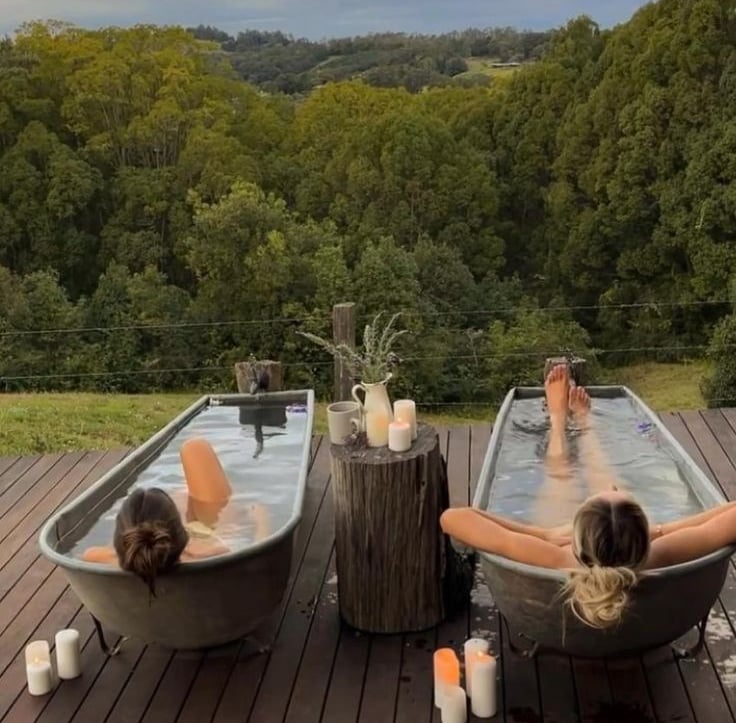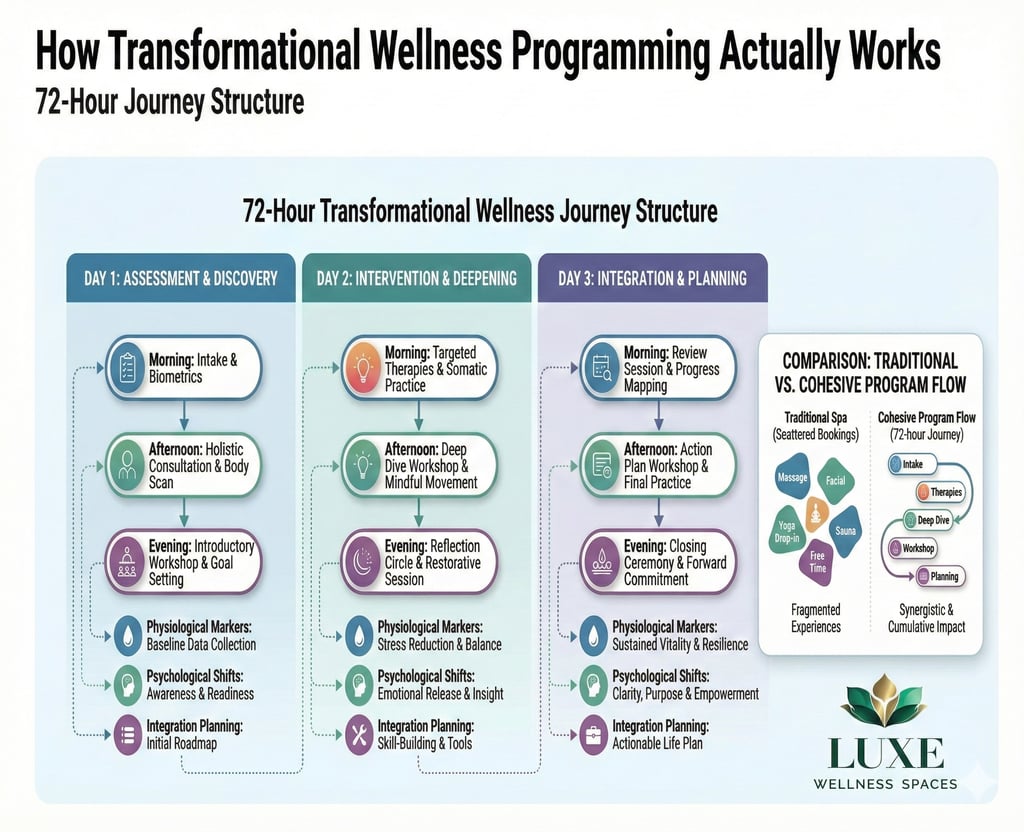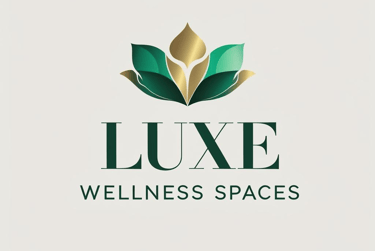How Wellness Resorts Are Replacing Itineraries with Immersion
Wellness travelers now demand transformational programming over packed itineraries. Learn how to design 3-day immersive experiences that build loyalty.
Daryn Berriman
11/21/202511 min read


Guests are canceling spa appointments mid-stay. Not because the massage was poor, but because they're exhausted from their "relaxation" schedule.
Transformational wellness programming replaces activity-based itineraries with immersive, outcome-driven experiences. Instead of booking ten 60-minute treatments across three days, today's wellness travelers seek physiological resets through longer, integrated programming like silent retreats, metabolic restoration protocols, and regenerative practices that connect them to place and purpose.
This isn't a trend. According to the Global Wellness Institute's 2023 research, the wellness tourism market reached $814 billion, with demand shifting dramatically toward "transformational travel" experiences that promise measurable mental and physical outcomes rather than passive relaxation.
A boutique resort in Northern California learned this the hard way. They'd built a world-class spa with 14 treatment rooms and a menu of 40 services. Occupancy averaged just 52% despite strong resort bookings.
When they restructured around three-day "metabolic reset" and "digital detox" programs in 2023, treatment room utilization jumped to 78% and guest spending increased by 34%. More importantly, their repeat guest rate climbed from 23% to 41% within eight months.
The stakes are clear: operators clinging to the traditional spa menu model are watching revenue per guest stagnate while competitors offering immersive programming capture both wallet share and loyalty.
The Financial Reality Behind Checklist Fatigue
Your guests aren't rejecting wellness. They're rejecting fragmentation.
McKinsey's 2024 wellness consumer research found that 68% of wellness travelers specifically seek "fewer, deeper experiences" rather than packed schedules. Yet most resort spas still operate on a transactional model built for a different era.
Consider the math. A traditional spa might generate $180 per guest across three separate 60-minute bookings. A three-day transformational program generates $1,200 to $2,800 per guest while requiring less operational complexity. You're not scheduling 15 individual appointments; you're managing one cohesive journey.
But here's what operators miss: Instead of focusing on raising prices, rather redesign the value proposition entirely.
How Transformational Wellness Programming Works
The framework isn't complicated, but it does require rethinking your operational structure.
Building the Three-Day Arc
Start with a clear physiological or psychological outcome. "Relaxation" isn't an outcome; "improved sleep quality measured through HRV" is an outcome. "Stress relief" is vague; "vagal tone restoration through breathwork and cold exposure" is specific.
We worked with a desert resort that replaced their a la carte spa with four signature programs: Metabolic Reset, Sleep Restoration, Creative Renewal, and Grief Integration. Each spans 72 hours minimum.
The Metabolic Reset program includes:
Day 1: Comprehensive biomarker assessment, circadian reset protocols, first nutritional intervention
Day 2: Movement practices, mitochondrial support treatments, metabolic meal experiences
Day 3: Integration session, personalized home protocols, three-month follow-up plan
Revenue per participating guest: $2,400. More significantly, 67% purchase the follow-up package.
The "Slow Luxury" Operational Model
Longer programming seems counterintuitive when you're used to maximizing treatment room turns. But the operational efficiency is actually superior.
Traditional model complexity:
8 practitioners managing 40+ individual appointments daily
Constant transition time between 30/60/90-minute slots
High no-show and cancellation disruption
Minimal upsell opportunity per touchpoint
Transformational programming simplicity:
2-3 practitioners per cohort of 6-8 guests
Predictable daily rhythm with built-in prep time
Pre-paid commitments with cancellation protection
Continuous relationship-building across 72+ hours
One resort operator told us: "I thought we'd need more staff. We actually reduced our practitioner count by 30% while increasing guest satisfaction scores by 41 points."
Regenerative Integration: The Loyalty Multiplier
Here's where most operators stop short. They build the program but miss the element that transforms satisfied guests into evangelists: a meaningful connection to place and community.
Research published in the Journal of Sustainable Tourism (2023) demonstrates that travelers who participate in regenerative activities (those that actively restore local ecosystems or communities) report 3.2x higher likelihood of returning and 4.1x higher likelihood of recommending the destination.
A coastal wellness resort in Mexico structured its programs around tidal cycles and local fishing community traditions. Guests participate in sustainable harvesting techniques with local fishermen, learn traditional preparation methods from community elders, and their program fees directly fund marine restoration projects visible from the property.
The result isn't just good marketing. It's a 58% repeat booking rate in an industry where 25% is considered strong.
The Silent Retreat Framework
Silent retreats represent the purest form of this programming shift, and they're experiencing explosive demand.
We've designed 10 silent retreat programs across North America and Europe since 2024. The framework that works:
Duration: Minimum 3 days, optimal 5-7 days.
Group size: 8-12 participants maximum.
Structure: 60% unstructured silence, 40% guided integration.
Support: Daily one-on-one check-ins, optional communication cards, designated "speaking zones"
One critical element operators underestimate: guests need pre-retreat preparation. We provide a two-week digital orientation that covers what to expect, how to handle discomfort, and practical logistics. Programs with robust pre-retreat support show 89% completion rates versus 67% without.
The economics work because these programs command $3,500 to $8,000 per person with minimal operational overhead once established.


The Costly Mistake Most Wellness Operators Make
They try to do both.
You cannot simultaneously optimize for treatment room turns and transformational depth. The operational systems, staffing models, marketing messages, and facility design requirements are fundamentally different.
We've watched operators launch "transformational programs" while maintaining their traditional spa menu, expecting guests to navigate both offerings. The result is confusion, diluted positioning, and mediocre performance in both categories.
A mountain resort in Colorado tried this hybrid approach for 18 months. Their new three-day programs attracted interested guests, but 43% of participants also booked individual spa treatments, fragmenting their experience and reducing the transformational impact. Guest satisfaction scores for the programs were tepid (7.2/10), and traditional spa revenue declined as staff attention shifted.
When they committed fully to the transformational model, removing the day spa menu entirely and repositioning as a "wellness immersion retreat," several things happened:
Advance booking windows extended from 12 days to 47 days
Average guest spending increased from $890 to $2,340
Staff turnover dropped from 38% to 11% annually
Guest satisfaction scores for programs jumped to 9.1/10
The mistake costs more than mixed results. It costs clarity, which costs conversion.
How Transformational Programming Compares to Traditional Spa Operations
Traditional Spa Menu Model:
Revenue: $120-300 per guest per day
Booking window: 0-14 days advance
Repeat guest rate: 15-25%
Operational complexity: High (scheduling, inventory, coordination)
Staff expertise required: Service delivery-focused
Guest relationship: Transactional, treatment-based
Cancellation impact: High disruption, difficult to fill
Transformational Programming Model:
Revenue: $400-950 per guest per day
Booking window: 30-90 days advance
Repeat guest rate: 40-60%
Operational complexity: Moderate (cohort-based, predictable)
Staff expertise required: Facilitation and outcome-focused
Guest relationship: Relational, journey-based
Cancellation impact: Lower (cohort buffer, waitlists common)
The comparison isn't about which is "better." It's about which aligns with where your market is moving and what your operation can deliver with excellence.
The Counter-Intuitive Truth About Wellness Programming
Less is more valuable, but only if you can articulate the "more."
Operators obsess over adding amenities, expanding treatment menus, and creating "unique" offerings. But the wellness traveler paying premium rates isn't impressed by your 47-treatment menu or your seventh type of massage.
They're asking a different question: "Will this change how I feel when I return home?"
The counterintuitive insight from four years of wellness consultancy work: the properties commanding the highest rates and deepest loyalty offer the fewest choices.
A wellness retreat in Cape Town offers exactly one program. That's it. No variations, no customization, no a la carte options. Seven-day silent meditation retreats, $4,200 per person, booked solid 11 months ahead with a 2,400-person waitlist.
Their website lists what you won't get:
No spa treatments
No menu options (meals are predetermined)
No Wi-Fi
No private rooms (shared accommodations only)
No flexibility in schedule
This violates every traditional hospitality principle. It works because it's radically clear about the outcome and the commitment required to achieve it.
You don't need to go this extreme. But you do need to understand the principle: constraints create value when they serve the transformation.
Designing Operational Systems for Depth
The programming is only half the equation. Your operational infrastructure must support multi-day immersion without burning out your team.
Staffing for Transformation
Traditional spa operations require specialists: massage therapists, estheticians, nail technicians. Transformational programming requires facilitators who can hold space across multiple modalities.
The staffing ratio that works: one lead facilitator per 4-6 guests, supported by subject specialists who rotate in for specific sessions. Your lead facilitator doesn't need to be an expert in breathwork, cold therapy, and nutrition. They need to be exceptional at creating psychological safety and guiding integration.
Most spa therapists can develop these skills, but it requires 40-60 hours of dedicated training plus supervised practice.
Technology Infrastructure
Forget your traditional spa booking software. You need systems designed for program management, not appointment scheduling.
Essential technology stack:
Program management platform with cohort tracking
Pre-retreat assessment and preparation delivery
In-program guest progress monitoring
Post-program follow-up automation
Outcome measurement tools
One resort spent $78,000 trying to retrofit its property management system to handle programs before investing in purpose-built software for $12,000 annually. The retrofit never worked properly.
Facility Design Considerations
Your beautiful spa treatment rooms might be the wrong infrastructure.
Transformational programming needs:
Large group gathering spaces (accommodate 8-12 comfortably)
Transitional quiet zones between activities
Outdoor integration spaces regardless of climate
Flexible spaces that support multiple modalities
Less focus on luxury finishes, more on acoustic design and natural light
A boutique hotel in Phuket, Thailand, converted four traditional treatment rooms into two large multi-use spaces. Initial concern about losing capacity proved unfounded. The new spaces accommodate their three-day programs more effectively, and revenue per square foot increased 127%.
Measuring What Matters: Beyond Satisfaction Scores
Traditional spa metrics miss the point entirely.
Guest satisfaction scores and online reviews matter, but they're lagging indicators. The metrics that predict long-term success in transformational programming:
Commitment indicators:
Advance booking window (longer is better, indicates demand strength)
Deposit to full payment conversion rate (should exceed 94%)
Pre-program engagement rate (participation in preparation materials)
Outcome indicators:
Guest-reported outcome achievement (measured at 30 and 90 days post-program)
Biometric improvement where applicable (HRV, sleep quality, etc.)
Integration plan adherence (are guests following through at home?)
Loyalty indicators:
Repeat program booking rate (target 45%+)
Referral rate (transformational guests typically refer 2-3 others)
Community engagement (participation in alumni offerings, online groups)
A wellness resort in Arizona tracks "transformation completion rate": the percentage of guests who report sustained behavior change 90 days post-program. Their current rate is 62%, which correlates directly with their 47% repeat booking rate.
When satisfaction is high (9/10) but transformation completion is low (below 40%), it indicates pleasant but ultimately forgettable programming.
The Regenerative Layer: Building Purpose Into Practice
This is the element that separates competent transformational programming from exceptional experiences that build generational loyalty.
Regenerative practices aren't CSR window dressing. They're structural elements that give guests a sense of contribution and connection to place.
What regenerative integration looks like in practice:
A forest retreat in Knysna, South Africa, structures programs around watershed restoration. Guests participate in native plant propagation, stream monitoring, and erosion control work as part of their daily routine. The work isn't strenuous; sessions are 45-60 minutes and integrated with reflection time.
The ecological impact is measurable: 14,000 native plants established, 2.3 miles of streambank stabilized. But the business impact is more significant: 71% of guests describe their experience as "life-changing" versus 34% at comparable properties without regenerative elements.
The framework we use:
Identify local ecological or community need (authentic, not manufactured)
Partner with established local organizations (don't create new initiatives)
Design guest participation that creates real value (not symbolic activities)
Make the impact visible and measurable (guests see results during their stay)
Connect the regenerative work to guests' personal transformation (facilitated reflection)
The cost to integrate regenerative programming is minimal, typically $15-30 per guest. The perceived value addition is substantial, often justifying $200-400 premium in program pricing.


The Role of Follow-Up in Guest Retention
The transformation doesn't end when guests check out. The integration period that follows is actually more critical than the retreat itself.
Programs without structured follow-up see 18-22% repeat booking rates. Programs with comprehensive 90-day integration support see 45-52% repeat rates.
Effective follow-up structure:
Week 1 post-program: Check-in email, integration plan review.
Week 2: Video message from lead facilitator.
Week 4: Group video call with cohort (optional attendance).
Week 8: Progress assessment, adjustment recommendations.
Week 12: Completion celebration, next program invitation.
One wellness center implements monthly alumni gatherings (virtual and in-person options). These events require minimal staff time but generate substantial goodwill. More importantly, 34% of alumni event participants book their next program within 60 days of attending.
The follow-up infrastructure costs approximately $40 per guest in staff time and platform fees. The return on that investment through increased repeat bookings exceeds 15:1.
Programming for the Guest You're Becoming
The checklist vacation isn't dead because travelers became more sophisticated. It's dead because it never delivered what guests actually wanted: to return home different than they arrived.
Transformational wellness programming succeeds because it honors that fundamental human desire for change. When you structure experiences around depth rather than breadth, outcomes rather than activities, and integration rather than consumption, you create value that guests can't find elsewhere.
The operators thriving in this evolution aren't necessarily the ones with the biggest budgets or most luxurious facilities. They're the ones who've committed to a clear promise and built the operational systems to deliver it consistently.
Ready to transition your wellness offering from transactional to transformational? Luxe Wellness Spaces has guided 10+ properties through this evolution. We'll assess your current operations, design your signature programming, train your team, and support your launch. Schedule a complimentary consultation to explore what transformational wellness programming looks like for your property.
FAQs
Q: What is transformational wellness programming? A: Transformational wellness programming replaces individual spa treatments with multi-day immersive experiences designed to achieve specific physiological or psychological outcomes like metabolic reset, sleep restoration, or stress resilience. Rather than booking separate 60-minute services, guests commit to integrated 3-7 day journeys that include assessments, guided practices, educational components, and follow-up support. This approach typically generates 3-4x higher revenue per guest while building stronger loyalty than traditional spa models.
Q: How long should a transformational wellness program be? A: Effective transformational programs run a minimum of 3 days, with optimal results at 5-7 days for deep outcomes. Three-day programs work well for metabolic resets, digital detoxes, and introductory experiences. Five to seven-day programs allow for more profound shifts in sleep patterns, stress response, or behavioral change. Programs shorter than 3 days rarely provide sufficient time for physiological adaptation and integration. The Global Wellness Institute reports that guests in 5+ day programs demonstrate 2.3x higher sustained behavior change at 90 days post-program compared to shorter formats.
Q: What's the difference between a spa retreat and transformational wellness programming? A: A spa retreat typically bundles existing treatments into multi-day packages focused on relaxation and pampering. Transformational wellness programming designs cohesive journeys around specific outcomes with integrated practices, educational elements, and structured follow-up. Spa retreats average $150-300 per person per day with 15-25% repeat rates; transformational programs average $400-950 per day with 40-60% repeat rates. The operational model differs significantly: spa retreats require high scheduling complexity and individual service delivery, while transformational programs use cohort-based facilitation with predictable rhythms.
Q: How much does it cost to launch transformational wellness programming? A: Initial investment ranges from $25,000 to $150,000 depending on facility readiness and scope. Core costs include: program design and documentation ($8,000-$15,000), staff training and certification ($12,000-$35,000 for 3-5 facilitators), technology platforms ($3,000-$8,000 first year), facility modifications if needed ($0-$60,000), and marketing/positioning ($5,000-$20,000). Most operators achieve break-even within 6-9 months of launching their first program. The ROI typically exceeds 300% by year two through increased revenue per guest and reduced operational complexity compared to traditional spa models.
Q: Can traditional spa staff transition to facilitating transformational programs? A: Yes, with proper training. Approximately 60-70% of experienced spa therapists successfully transition to wellness facilitation roles with 40-60 hours of dedicated training. The skill set shifts from technical service delivery to holding space, guiding integration, managing group dynamics, and coaching outcomes. Success factors include emotional intelligence, a genuine interest in transformation work, and a willingness to develop trauma-informed communication skills. Properties that invest in comprehensive facilitator training see 85%+ staff retention compared to 60-65% retention in traditional spa operations.
Q: How do you price transformational wellness programming compared to spa services? A: Price based on outcome value, not time. While a 60-minute massage might be $180, a 3-day metabolic reset program that demonstrably improves sleep and energy commands $1,800-$2,800. Research your target market's willingness to pay for specific outcomes, not industry spa averages. Include all elements in one price: assessments, practices, meals, accommodations, materials, and follow-up support. Programs priced 15-25% above comparable market offerings actually convert better than those priced at market average, as higher pricing signals more comprehensive transformation and attracts more committed participants.
Further reading on our blog: Further reading on our blog: 'Spa Consultant Benefits: Strategic Investment for Wellness.'
Explore our Spa & Wellness Consultancy to scope project phases and services.
See how we structure Fitness and Leisure concepts before you commit to equipment.
Learn why Luxe Wellness Spaces blends design, operations, and growth under one roof.
REFERENCE LIST
Global Wellness Institute - 2023 Wellness Tourism Report - Wellness tourism market valuation and transformational travel demand data
McKinsey & Company - 2024 Wellness Consumer Insights - Consumer preference research on wellness experience depth versus breadth
Journal of Sustainable Tourism - 2023 - Research on regenerative tourism practices and guest loyalty correlation
Hospitality Net Industry Reports - Spa and wellness operational benchmarks and performance metrics
About The Author
Daryn Berriman is the Founder and Principal Consultant of Luxe Wellness Spaces, a consulting-led studio blending operational expertise and design excellence to create wellness businesses that perform, and spaces that guests love.


